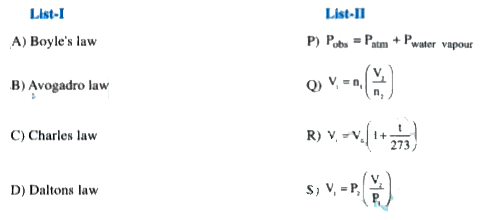Which of the following indicates Charles' law mathematically (when n, P are constant)?
1) VT = constant
2) V1=V0(t+1273)
3) V0=V1(1+1273)
4) V/T = constant (when n,P are constant)Solution in Telugu
1,3
1,2
2,3
2,4
The correct Answer is:D
Step by step video, text & image solution for Which of the following indicates Charles' law mathematically (when n, P are constant)? 1) VT = constant 2) V_(1) = V_(0) (t + 1/273) 3) V_(0) = V_(1)(1+ 1/273) 4) V/T = constant (when n,P are constant) by Chemistry experts to help you in doubts & scoring excellent marks in Class 12 exams.
Topper's Solved these Questions
- BOOK - AAKASH SERIESCHAPTER - STATES OF MATTER EXERCISE - LECTURE SHEET (EXERCISE-I) (LINKED COMPREHENSION TYPE QUESTIONS) Passage-I5videos
STATES OF MATTER
- BOOK - AAKASH SERIESCHAPTER - STATES OF MATTER EXERCISE - LECTURE SHEET (EXERCISE-I) (MATRIX MATCHING TYPE QUESTIONS)2videos
STATES OF MATTER
- BOOK - AAKASH SERIESCHAPTER - SOLUTIONS EXERCISE - Objective Exercise -450videos
SOLUTIONS
- BOOK - AAKASH SERIESCHAPTER - STOICHIOMETRYEXERCISE - PRACTICE SHEET (ADVANCED) (INTEGER TYPE QUESTION)2videos
STOICHIOMETRY
Similar Questions
Variation of volume with temperature was first studied by French chemist, Jacques Charles, in 1787 and then extended by another French chemist Joseph Gay-Lussac in 1802. For a fixed mass of a gas under isobaric condition, variation of volume V with temperature t°C is given by V = V0[l+αt] where V0 is the volume at 0°C, at constant pressure.
1 or every 1° change in temperature, the volume of the gas changes by............... of the volume at 0∘ C02:22View Solution 03:48View Solution
03:48View SolutionAssertion : Molarity of a solution decreases with an increase of temperature
Reason : As temperature increases volume of the solution increases.01:11View SolutionAmmonia is oxised by oxygen to give nitric oxide and water. The weight of water produced per gram of nitric oxide is 0.1×xg. What is value of d.
01:27View SolutionOne mole of an ideal gas undergoes a process
p=p01+(VV0)2
where p0and V0 are constants. Find temperature of the gaas when V=V0.02:24View SolutionOne mole of an ideal gas undergoes a process P=P0[1+(2V0V)2]−1, where P0V0 are constants. Change in temperature of the gas when volume is changed from V=V0→V=2V0 is:
02:24View SolutionThe pressure p of a gas is plotted against its absolute temperature T for two different constant volumes, V_(1) and V_(2) when V_(1) gt V_(2) , the
05:09View SolutionFor one mole of ideal gas if P=(P_(0))/(1+((V)/(V_(0)))) where P_(0) and V_(0) are constant, then temperature of gas when V=V_(0) is:
02:51View Solutionनिम्नलिखित समीकरण किस नियम को दर्शाती है ?
Vt=V0(1+t273)
इस नियम को अन्य प्रकार से परिभाषित कीजिए ।03:26View Solutionनिम्नलिखित समीकरण किस नियम को दर्शाती है ?
Vt=V0(1+t273)
इस नियम को अन्य प्रकार से परिभाषित कीजिए ।04:02View SolutionOne mole of an ideal gas with heat capacity at constant pressure C_(P) undergoes the process T=T_(0)+alpha V where T_(0) and a are constants.If its volume increases from V_(1)toV_(2) the amount of heat transferred to the gas is C_(P)RT_(0)ln((V_(2))/(V_(1))) alpha C_(P)((V_(2)-V_(1)))/(RT_(0))ln((V_(2))/(V_(1))) alpha C_(P)(V_(2)-V_(1))+RT_(0)ln((V_(2))/(V_(1)))
01:25View SolutionThe position of a particle at time t is given by the equation x(t) = V_(0)/A (1-e^(At)) V_(0) = constant and A > 0 Dimensions of V_(0) and A respectively are
02:12View SolutionThe instantaneous position of a particle is given by S(t) = V_(0) (1 - e^(-at))//a , where a and V_(0) are constants and a gt 0 . What are the dimensions of a and V_(0) ?
02:12View SolutionThe position x of a particle at time t is given by : x=(v_(0))/(a)(1-e^(-at)) where v_(0) is a constant and a>0. The dimensional formula of v_(0) and a is :
03:33View SolutionThe position x of a particle at time t is given by x=V0a(1−e−at), where V0 is constant and a>0. The dimensions of V0 and a are
View Solution

